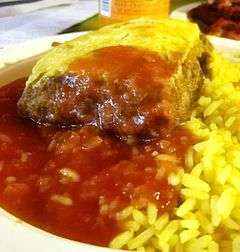Bobotie
Bobotie (Afrikaans: [bəˈbuəti]) is a well-known[1] South African dish consisting of spiced minced meat baked with an egg-based topping.[2]
 Bobotie with yellow rice and chutney. | |
| Place of origin | South Africa |
|---|---|
| Main ingredients | Minced meat |
Origin of name and recipe
Bobotie appears to be a variant of Patinam ex lacte, a dish documented by the ancient Roman writer Apicius, layers of cooked meat, pine nuts, and seasoned with pepper, celery seeds and asafoetida. These were cooked until the flavours had blended, when a top layer of egg and milk was added. When the latter had set, the dish was ready to be served.[3] C. Louis Leipoldt, a South African writer and gourmet, wrote that the recipe was known in Europe in the seventeenth century.[4]
The origin of the word bobotie is contentious. The Afrikaans etymological dictionary claims that the probable origin is the Malayan word boemboe, meaning curry spices.[5] Others think it to have originated from bobotok,[6] an Indonesian dish which consisted of totally different ingredients.[7] The first recipe for bobotie appeared in a Dutch cookbook in 1609.[7] Afterwards, it was taken to South Africa and adopted by the Cape Malay community.[2] It is also made with curry powder, leaving it with a slight "tang".[8] It is often served with sambal.[9] The dish has been known in the Cape of Good Hope since the 17th century, when it was made with a mixture of mutton and pork.[10]
Preparation
Today, bobotie is much more likely to be made with beef or lamb, although pork lends the dish extra moisture. Early recipes incorporated ginger, marjoram and lemon rind; the introduction of curry powder has simplified the recipe but the basic concept remains the same. Some recipes also call for chopped onions and almonds to be added to the mixture. Traditionally, bobotie incorporates dried fruit like raisins or sultanas. It is often garnished with walnuts, chutney and bananas.[11] Although not particularly spicy, the dish incorporates a variety of flavours that can add complexity. For example, the dried fruit (usually apricots and raisins/sultanas) contrasts the curry flavouring. The texture of the dish is also complex, the baked egg mixture topping complementing the milk-soaked bread which adds moisture to the dish. Bobotie is usually served with "yellow rice", which is rice cooked with turmeric.
Leipoldt's recipe
Leipoldt's recipe book published in 1933 calls for finely minced meat, breadcrumbs, milk, onions and butter and a curry sauce made with spices, sugar, lemon juice, chilli pepper and vinegar. This is baked with a topping of egg and milk.[12]
Tulleken's recipe
A 1923 recipe by Mrs S. van H. Tulleken uses mutton, almonds, bitter almond essence, onions, butter, bread, curry powder, lemon juice, eggs and sugar, baked with a custard topping of eggs and milk.[13]
Bobotie elsewhere in Africa
Bobotie recipes were transported by South African settlers to other parts of Africa. Today, recipes for it can be found that originated in white settler communities in Kenya, Botswana, Zimbabwe and Zambia. There is a variation that was popular among the 7,000 Boer settlers who settled in the Chubut River Valley in Argentina in the early 20th century, in which the bobotie mixture is packed inside a large pumpkin, which is then baked until tender.
In culture
2008 Augusta National Champions Dinner
Bobotie was selected by 2008 Masters golf champion and South African native Trevor Immelman as the featured menu item for Augusta National's annual "Champions Dinner" in April 2009. Each year, the reigning champion at The Masters golf tournament, played every year in Augusta, Georgia, hosts the gathering and tends to create a menu featuring delicacies from his home region.[14]
2014 Epcot International Food and Wine Festival
South African Bobotie is one of the featured items on the menu; it is also served with turkey and mushrooms. It is listed as gluten free. It is also on the every day menu at the buffet restaurant Boma at Disney's Animal Kingdom Lodge.[15]
See also
- Cook and Enjoy It, a cookbook by S.J.A. de Villiers
- List of African dishes
- List of meat dishes
References
- Crais, C.; McClendon, T.V. (2013). The South Africa Reader: History, Culture, Politics. The World Readers. Duke University Press. p. 64. ISBN 978-0-8223-7745-0.
- "Bobotie" – Times Live
- Claassens, H.W., Die Geskiedenis van Boerekos 1652-1806, unpublished D.Phil. thesis, University of Pretoria, 2003, pp. 195–6.
- C. Louis Leipoldt, Leipoldt's Cape Cookery, Cape Town, 1976, p. 16.
- Etimologiewoordeboek van Afrikaans, WAT, 2003, p. 58.
- Theodora Hurustiati (10 November 2013). "Bobotie's melting pot". The Jakarta Post. Retrieved 12 May 2015.
- Smit, S., and Fulton, M. (1983) The South African Encyclopedia of Food and Cookery. Cape Town; C Struik.
- "Bobotie Is South African Favorite" – The Hartford Courant
- "Sampling South Africa Cooks Meld Far Flung Cuisines to Create a Flavor for a Nation" – Richmond Times
- "Bobotie, South Africa's Indigenous Cuisine" – New York Times
- "Bobotie, a local and international winner" – Independent Online
- Leipoldt, C. Louis, Kos vir die Kenner, Human & Rossouw, 2011, p. 253.
- Tulleken, S. van H., The Practical Cookery Book for South Africa, 22nd edition, 1947, p. 133.
- "On the Menu: The Champions Dinner at The Masters" – About.com
- "AFRICA – 2014 EPCOT INTERNATIONAL FOOD & WINE FESTIVAL MENU". GuideWDW.com. Archived from the original on 14 October 2014. Retrieved 27 September 2014.